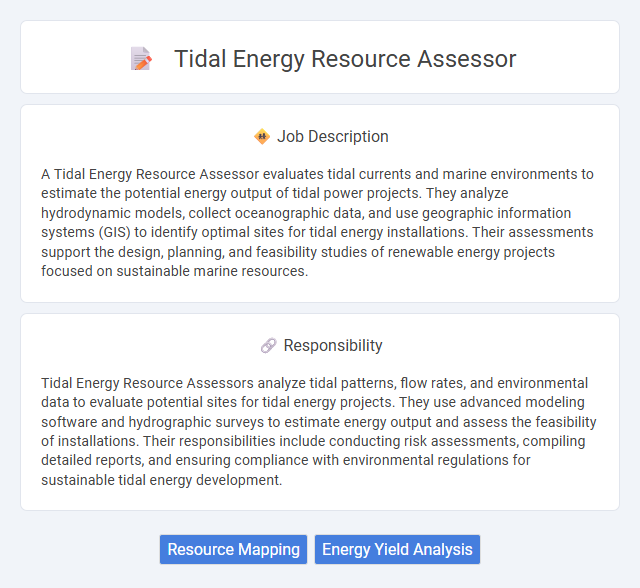
A Tidal Energy Resource Assessor evaluates tidal currents and marine environments to estimate the potential energy output of tidal power projects. They analyze hydrodynamic models, collect oceanographic data, and use geographic information systems (GIS) to identify optimal sites for tidal energy installations. Their assessments support the design, planning, and feasibility studies of renewable energy projects focused on sustainable marine resources.
Individuals with a strong background in marine science, engineering, or environmental studies are likely suitable for the role of a Tidal Energy Resource Assessor. Those who are comfortable with fieldwork in marine environments and possess analytical skills to evaluate tidal patterns and energy potential might find this job fitting. Physical endurance and proficiency in data interpretation could increase the probability of success in this position.
Qualification
A Tidal Energy Resource Assessor requires a strong foundation in marine engineering, oceanography, or renewable energy, supported by a bachelor's degree or higher. Proficiency in hydrodynamic modeling software and data analysis tools is essential for evaluating tidal currents and energy potential. Experience with geographic information systems (GIS) and environmental impact assessments enhances the ability to deliver precise tidal resource evaluations.
Responsibility
Tidal Energy Resource Assessors analyze tidal patterns, flow rates, and environmental data to evaluate potential sites for tidal energy projects. They use advanced modeling software and hydrographic surveys to estimate energy output and assess the feasibility of installations. Their responsibilities include conducting risk assessments, compiling detailed reports, and ensuring compliance with environmental regulations for sustainable tidal energy development.
Benefit
Tidal Energy Resource Assessor roles likely offer significant benefits, including contributing to sustainable energy development and supporting the transition to renewable power sources. The position may provide opportunities to work with cutting-edge marine technology and engage in critical environmental impact assessments. Professionals in this role could experience enhanced career growth prospects due to increasing global interest in renewable energy resources.
Challenge
The challenge of a Tidal Energy Resource Assessor role likely involves accurately modeling complex tidal flows and predicting energy output in diverse marine environments. Assessing environmental impacts and navigating regulatory constraints could complicate project feasibility studies. Managing uncertainties in data collection and technological limitations may further influence the reliability of resource assessments.
Career Advancement
Tidal Energy Resource Assessors play a crucial role in analyzing marine tidal patterns to optimize renewable energy projects, offering significant opportunities for career growth in the expanding blue energy sector. Expertise in hydrodynamic modeling, geographic information systems (GIS), and environmental impact assessments positions professionals for advancement into senior technical roles or project management within offshore renewable energy companies. Continuous development in emerging technologies and regulatory knowledge enhances prospects for leadership positions, contributing to sustainable energy solutions globally.
Key Terms
Resource Mapping
Tidal Energy Resource Assessors specialize in mapping tidal currents and analyzing hydrodynamic data to identify optimal sites for tidal energy installations. They utilize advanced GIS tools, remote sensing technologies, and in-situ measurements to create high-resolution resource maps that support feasibility studies and environmental impact assessments. Accurate tidal resource mapping is critical for maximizing energy extraction efficiency and minimizing ecological disruptions in coastal and estuarine environments.
Energy Yield Analysis
Energy Yield Analysis in the Tidal Energy Resource Assessor role involves evaluating tidal current data, bathymetric maps, and hydrodynamic models to forecast potential energy production from tidal streams. The assessor utilizes software tools and simulation techniques to quantify power density and estimate annual energy output, considering site-specific variables such as tide height and flow velocity. Accurate energy yield projections are essential for optimizing turbine placement, informing project feasibility, and supporting investment decisions in tidal energy developments.
 kuljobs.com
kuljobs.com